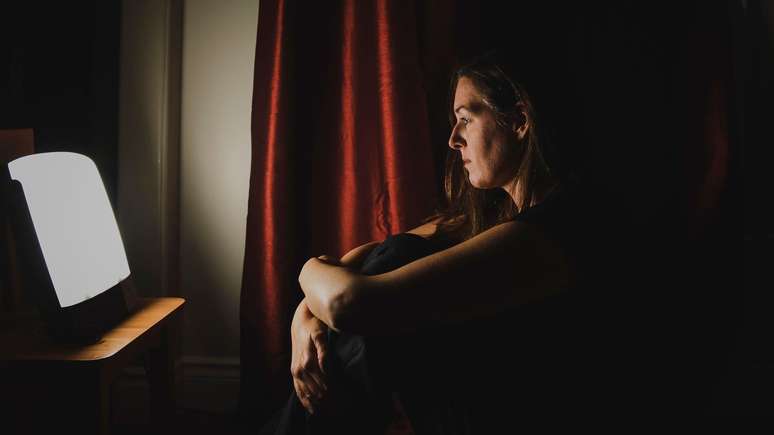Studies have concluded that approximately 10% of the population in the far north of the planet, such as Alaska and Finland, suffer from seasonal affective disorder (SAD).
Have you ever noticed that you sleep more in the winter months? Or eat more carbohydrates or consume less energy?
If your answer is “yes” and you live in a high-latitude region, you may be part of the approximately 6% of the population in those regions who suffer from seasonal affective disorder (SAD).
And if you’re looking online for advice on how to combat winter blues, you’ve probably been advised to buy a therapy lamp. And you may be wondering what the research says about how it works and how effective it is.
Before we look at the evidence on phototherapy, it’s important to understand why mood can be affected by sunlight.
Our body produces vitamin D when the skin is exposed to sunlight. And some scientists believe there is a correlation between depression and low vitamin D levels.
Studies have concluded that about 10% of the population in the far north of the planet, such as Alaska and Finland, suffer from SAD.
But interestingly, Icelanders, who also live at high latitudes in the Northern Hemisphere, appear to suffer less from SAD.
This may be due to their fish-based diet, which is rich in vitamin D.
Light also stimulates our visual system, regulating the activity of the so-called circadian rhythm. This is a small region of the brain called the suprachiasmatic nucleus (SCN).
The SCN receives direct input from the retina and also contains melatonin receptors. And melatonin supplements are now being offered to treat depression.
For all of this, there are several reasons why light may be important for mood.
SAD was first described around 1980 in the United States, when a man suffering from the symptoms described above invented a light box for his own treatment.
Since then, many studies have emerged examining phototherapy in SAD. Its results are diverse and contradictory.
But all this data can be combined and verified using meta-analysis to provide a more accurate overall picture.
The meta-analysis brings together the findings of several independent studies. Numerous meta-analyses have been carried out on this topic, and most of them demonstrate that phototherapy has a positive effect, not only on SAD, but also on major depression.
Is light intensity important?
The intensity of light is measured in units called lux.
A meta-analysis of 39 scientific studies, conducted in 1999, concluded that strong light intensity (6000-10,000 lux) has a greater effect than medium intensity light (1700-3500 lux). And medium light intensity had a greater effect than dim lighting (less than 600 lux) on depressive symptoms in people with SAD.
A meta-analysis of 19 studies conducted in 2019 also concluded that brighter light (more than 1000 lux) is needed to treat SAD.
Researchers are studying whether lamps used to treat seasonal affective disorder can also help fight non-seasonal depression.
You may be wondering if the color of the light also makes a difference.
A 1997 meta-analysis examined 40 scientific studies on different colors of light.
And it revealed that short- to medium-wavelength light (blue, green, and yellow) was effective, but that red light and ultraviolet wavelengths were apparently not helpful in treating SAD.
This study also looked at the timing of phototherapy. The data may not be significant (i.e., more studies are needed), but they indicate that phototherapy administered in the morning and evening was more effective than in the evening or morning alone.

Does light therapy work for non-seasonal depression?
A meta-analysis of 23 studies conducted in 2005 concluded that phototherapy works for people with SAD and for people with nonseasonal depression.
This analysis tested six studies of combination treatment for nonseasonal depression and concluded that phototherapy, while effective alone, did not produce a greater effect on depression symptoms when given in combination with antidepressant medications.
But more recent studies agree that combined treatment is more effective.
A meta-analysis of 10 studies conducted in 2016 found an improvement in treating depression with medications combined with phototherapy. And a meta-analysis of seven studies carried out in 2019 also concluded that phototherapy increases the power of antidepressants.
Therefore, if you suffer from non-seasonal depression, phototherapy may work as your primary treatment and will likely amplify the effects of any antidepressant medications you may be taking.
There is another condition called SAD subsyndrome (SSAD or sub-SAD), which affects approximately 10-15% of the population living at higher latitudes. Its symptoms are milder or less frequent than those of SAD, and sub-SAD can also be treated with phototherapy.
Vitamin D is essential for physical and mental health. It regulates calcium and phosphate levels and is essential for good bone density and healthy muscles and teeth. And it is also essential for a healthy immune system.
There are other studies that look at workplace lighting and its effect on professionals. Some types of light, for example, can improve alertness, while other lights can increase headaches.
If you suffer from SAD, choose a higher intensity light for a faster effect and use it for longer periods of time, such as in morning and evening sessions.
Avoid ultraviolet light, which is ineffective against SAD and can cause sunburn or skin cancer.
And don’t forget to eat fish to boost your vitamin D levels.
*Colin Davidson is Professor of Neuropharmacology at the University of Central Lancashire, UK.
Claire Hutchinson is Professor of Experimental Psychology at the University of the West of Scotland, UK.
This article was originally published on the academic news website The conversation and republished under a Creative Commons license. Read the original English version here.
Source: Terra
Ben Stock is a lifestyle journalist and author at Gossipify. He writes about topics such as health, wellness, travel, food and home decor. He provides practical advice and inspiration to improve well-being, keeps readers up to date with latest lifestyle news and trends, known for his engaging writing style, in-depth analysis and unique perspectives.








